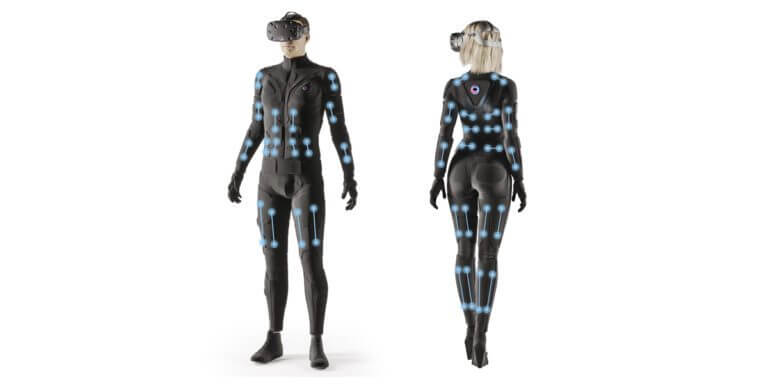This is the third post in a series of articles about haptics. This section characterizes TESLASUIT haptic feedback (aka, full body haptic suit).
We have recently released the article about the history of haptic feedback in video game industry.
Our full body haptic suit provides realistic immersive sensations relating to the sense of touch by applying the simulated forces and electrical pulses to the user. These stimulations can be used to feel virtual objects in the VR/AR environment, control these virtual objects, and enhance the remote control of the system. Thereby, TESLASUIT greatly improves the AR/VR experience.
How does TESLASUIT haptic feedback work?
The principle of the sensitisation system of TESLASUIT is based on sending a tiny pulse of different amplitude, frequency, amperage to the electrode.
TESLASUIT combines two electrostimulation systems:
- TENS (Transcutaneous Electrical Neural (or Nerve) Stimulation;
- EMS (Electrical Muscle Stimulation).
Both systems stimulate nerve endings, which affect skin surface. In the case of EMS electric pulses would lead to muscle contractions, yet TENS doesn’t always lead to that as it is a method that uses milder and less penetrative electrical impulses.
When a virtual part of the body collides with a virtual object, the commutation unit device delivers pulses from a pulse generator to the electrodes located in the same area of the wearer’s real body.
The electrodes operate on the principle of successive inclusion or E-Cloud Stimulation. It allows a significant reduction in energy usage. Combining different variations of values and time for electrode operation creates the simulation of different virtual sensations applied to the physical world.
The electrical pulse allocation in TESLASUIT VR gaming suit could be alternating repetition, alternated boost or fading pulse signal. This is necessary for high-quality simulation of liquid, gas and fluid environment sense simulation. Wave-like distribution is typical for many physical phenomena. Implementation of the principle of alternating signal allows simulation as well as creating special effects.
TESLASUIT haptic feedback features
Our haptic VR suit has the following features.
68 haptic points
While the vibration spreads widely, to large areas of the body, electrotactile haptic points provide sensation to the certain area of the body. A large number of haptic points allows covering almost the whole body. The higher the density of the points, the more accurate sensation the wearer feels.

Haptic animations
To impose sensations on specific parts of the video haptic animations are used. Together with a soundtrack and subtitles, they create an overall scene of VR.
Pre-designed animations, which emulate the most popular effects, are stored in a haptic library.
Haptic library
TESLASUIT haptic library provides a range of sensations to targeted areas across the body including simultaneously stimulating multiple muscle groups. The initial library will contain up to 250 basic sensations.
Real-time simulations
Additional sensations that are not available in TESLASUIT haptic library are simulated in real time. The primary sensation is activated at the same time or with a small delay of secondary sensation.
Weight simulation
To provide gravity force and modulate mass of the virtual object, an electric pulse is applied to the group of various muscles. For instance, we have an apple, it has a certain mass. When a user takes an apple in his hand, the specific muscle groups contract. Consequently, our haptic feedback suit can artificially stimulate these areas of muscles, emulating the mass of some object.
The latest (at the time of publication) research of Hasso Plattner Institute (Germany) describes in detail weight simulation by means of electrotactile feedback.
User calibration profiles
Calibration profiles allow to adapt TESLASUIT haptic feedback to a specific type of skin. These profiles are stored in the cloud and then can be applied to another suit.
Capillary system
The artificial capillary system distributes conductive fluid through TESLASUIT. It’s necessary for the improvement of the contact between the skin and haptic points.
Animation Customizing
Users can create custom animations with Haptic Editor application.
If you want to ask any specific details, please, feel free to contact us or comment below.
Haptics topic will be continued by the artcile “Why VR can’t be full-fledged without haptic”.
